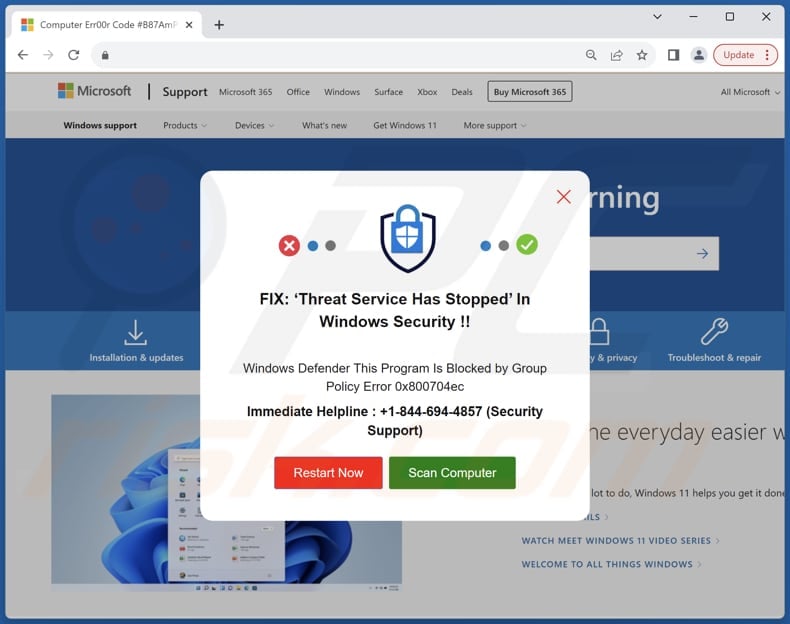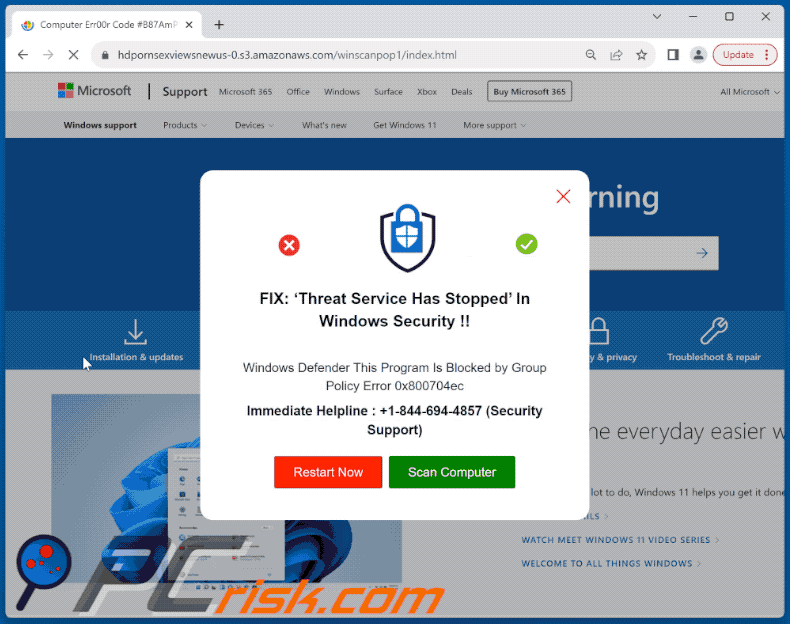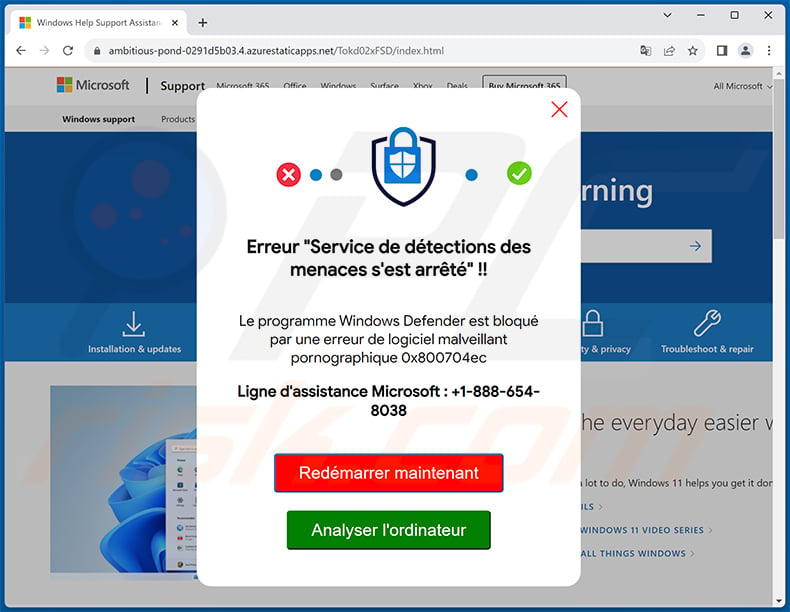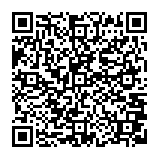How to avoid falling for scams like "Threat Services Has Stopped"
![]() Written by Tomas Meskauskas on (updated)
Written by Tomas Meskauskas on (updated)
What kind of scam is "Threat Service Has Stopped"?
Our examination of this page has demonstrated that it is a technical support scam site aiming to trick visitors into performing certain actions. The site likely employs misleading tactics to create a sense of urgency or a fabricated need for technical assistance, ultimately coercing users into taking actions that could compromise their security or lead to unwanted outcomes.

"Threat Service Has Stopped" scam overview
The message displayed on this technical support scam page presents itself as a solution for a purported issue. Also, it mentions an error (0x800704ec). To add a sense of urgency and legitimacy, it includes an immediate helpline number, +1-844-694-4857, labeled as "Security Support".
The fake message includes two action buttons, namely, "Restart Now" and "Scan Computer". Clicking on any of these buttons opens another scam page ("Windows Defender Security Center"). The ultimate goal of this technical support scam is to trick users into calling scammers.
Threats posed by technical support scams
Falling victim to technical support scams can result in a range of potential harms, including financial and data security. Scammers often employ deceptive tactics to convince users that their systems are infected or facing critical errors, prompting victims to provide remote access to their computers or divulge sensitive information.
Once scammers gain access, they may install malicious software, compromise personal data, or even lock users out of their systems until a ransom is paid. A couple of examples of scams used to trick users into providing remote access to computers are the TeamViewer scam and UltraViewer scam.
Financial losses can occur through various means, such as charging exorbitant fees for unnecessary services, tricking victims into purchasing fake security software or coercing them to disclose banking details. The compromised information may also be exploited for identity theft or other fraudulent activities.
| Name | Threat Service Has Stopped technical support scam |
| Threat Type | Phishing, Scam, Social Engineering, Fraud |
| Fake Claim | Threat service has stopped |
| Disguise | Warning from Microsoft |
| Tech Support Scammer Phone Number | +1-844-694-4857, +1-888-654-8038, +1-888-866-7401, +1-888-556-2848, +1-888-853-3816, +1-888-619-5209 |
| Associated Scam | Windows Defender Security Center |
| Symptoms | Fake error messages, fake system warnings, pop-up errors, hoax computer scan. |
| Distribution methods | Compromised websites, rogue online pop-up ads, potentially unwanted applications. |
| Damage | Loss of sensitive private information, monetary loss, identity theft, possible malware infections. |
| Malware Removal (Windows) | To eliminate possible malware infections, scan your computer with legitimate antivirus software. Our security researchers recommend using Combo Cleaner. |
Similar scams in general
Technical support scams typically share common characteristics designed to deceive and manipulate users. These scams often involve unsolicited messages or pop-ups claiming that the user's computer has issues, such as malware infections or system errors. They use fear tactics to create a sense of urgency, urging users to contact a specified helpline immediately.
Once in contact, scammers may request remote access to the user's computer, trick them into paying for unnecessary services, or gather sensitive information for fraudulent purposes. The common thread is the intent to exploit users through false claims about their device's security or functionality.
Examples of similar scams are "Our Security Scans Have Detected Potential Vulnerabilities", "Your PC Has Been DDoS Attacked And Infected With Viruses", and "Windows EROOR CODE 0X02333".
How did I open a scam website?
Users can inadvertently open scam websites through various means, often involving deceptive tactics. One common method is through phishing emails or messages that mimic legitimate sources, enticing users to click links leading to fraudulent sites.
Additionally, malicious ads or pop-ups on seemingly harmless websites may redirect users to scam pages when clicked. Another avenue is the use of misleading search engine results, where scammers manipulate SEO to have their deceptive sites appear prominently in search listings. Adware can also lead to unreliable pages.
How to avoid visiting scam pages?
Be cautious when clicking on links, especially those received through unsolicited emails or messages. Do not trust ads, "Download" buttons, and pop-ups on questionable websites. Download apps from official pages and reputable app stores to avoid downloading adware and other unwanted software.
Do not allow suspicious web pages to deliver notifications. Stay informed about common online scams and tactics. Install and regularly update reputable antivirus or anti-malware software to provide an additional layer of protection. If your computer is already infected with unwanted apps, we recommend running a scan with Combo Cleaner Antivirus for Windows to automatically eliminate them.
The appearance of "Threat Service Has Stopped" pop-up scam (GIF):

Text presented in the fake message:
FIX: 'Threat Service Has Stopped' In Windows Security
Windows Defender This Program Is Blocked by Group Policy Error 0x800704ec
Immediate Helpline : +1-844-694-4857 (Security Support)
[Restart Now] [Scan Computer]
A French variant of "Threat Service Has Stopped" pop-up scam:

Text presented within:
Erreur "Service de détections des menaces s'est arrêté" !!
Le programme Windows Defender est bloqué par une erreur de logiciel malveillant pornographique 0x800704ec
Ligne d'assistance Microsoft :
+1-888-654-8038[Redémarrer maintenant]
[Analyser l'ordinateur]
Instant automatic malware removal:
Manual threat removal might be a lengthy and complicated process that requires advanced IT skills. Combo Cleaner is a professional automatic malware removal tool that is recommended to get rid of malware. Download it by clicking the button below:
▼ DOWNLOAD Combo Cleaner
By downloading any software listed on this website you agree to our Privacy Policy and Terms of Use. To use full-featured product, you have to purchase a license for Combo Cleaner. 7 days free trial available. Combo Cleaner is owned and operated by Rcs Lt, the parent company of PCRisk.com read more.
Quick menu:
- What is Threat Service Has Stopped technical support scam?
- How to identify a pop-up scam?
- How do pop-up scams work?
- How to remove fake pop-ups?
- How to prevent fake pop-ups?
- What to do if you fell for a pop-up scam?
How to identify a pop-up scam?
Pop-up windows with various fake messages are a common type of lures cybercriminals use. They collect sensitive personal data, trick Internet users into calling fake tech support numbers, subscribe to useless online services, invest in shady cryptocurrency schemes, etc.
While in the majority of cases these pop-ups don't infect users' devices with malware, they can cause direct monetary loss or could result in identity theft.
Cybercriminals strive to create their rogue pop-up windows to look trustworthy, however, scams typically have the following characteristics:
- Spelling mistakes and non-professional images - Closely inspect the information displayed in a pop-up. Spelling mistakes and unprofessional images could be a sign of a scam.
- Sense of urgency - Countdown timer with a couple of minutes on it, asking you to enter your personal information or subscribe to some online service.
- Statements that you won something - If you haven't participated in a lottery, online competition, etc., and you see a pop-up window stating that you won.
- Computer or mobile device scan - A pop-up window that scans your device and informs of detected issues - is undoubtedly a scam; webpages cannot perform such actions.
- Exclusivity - Pop-up windows stating that only you are given secret access to a financial scheme that can quickly make you rich.
Example of a pop-up scam:

How do pop-up scams work?
Cybercriminals and deceptive marketers usually use various advertising networks, search engine poisoning techniques, and shady websites to generate traffic to their pop-ups. Users land on their online lures after clicking on fake download buttons, using a torrent website, or simply clicking on an Internet search engine result.
Based on users' location and device information, they are presented with a scam pop-up. Lures presented in such pop-ups range from get-rich-quick schemes to fake virus scans.
How to remove fake pop-ups?
In most cases, pop-up scams do not infect users' devices with malware. If you encountered a scam pop-up, simply closing it should be enough. In some cases scam, pop-ups may be hard to close; in such cases - close your Internet browser and restart it.
In extremely rare cases, you might need to reset your Internet browser. For this, use our instructions explaining how to reset Internet browser settings.
How to prevent fake pop-ups?
To prevent seeing pop-up scams, you should visit only reputable websites. Torrent, Crack, free online movie streaming, YouTube video download, and other websites of similar reputation commonly redirect Internet users to pop-up scams.
To minimize the risk of encountering pop-up scams, you should keep your Internet browsers up-to-date and use reputable anti-malware application. For this purpose, we recommend Combo Cleaner Antivirus for Windows.
What to do if you fell for a pop-up scam?
This depends on the type of scam that you fell for. Most commonly, pop-up scams try to trick users into sending money, giving away personal information, or giving access to one's device.
- If you sent money to scammers: You should contact your financial institution and explain that you were scammed. If informed promptly, there's a chance to get your money back.
- If you gave away your personal information: You should change your passwords and enable two-factor authentication in all online services that you use. Visit Federal Trade Commission to report identity theft and get personalized recovery steps.
- If you let scammers connect to your device: You should scan your computer with reputable anti-malware (we recommend Combo Cleaner Antivirus for Windows) - cyber criminals could have planted trojans, keyloggers, and other malware, don't use your computer until removing possible threats.
- Help other Internet users: report Internet scams to Federal Trade Commission.
Frequently Asked Questions (FAQ)
What is a pop-up scam?
A pop-up scam is a deceptive tactic where fraudulent pop-up messages appear on a user's screen, often claiming that the computer has viruses, errors, or security issues. These pop-ups typically use alarming language and visuals to create a sense of urgency, urging users to take immediate action, such as calling a fake tech support number or clicking on a malicious link.
What is the purpose of a pop-up scam?
The goal is to deceive unsuspecting users into providing sensitive information, granting remote access to their computers, or paying for unnecessary services, all while exploiting the user's concern for their device's security.
Why do I encounter fake pop-ups?
Users may end up on scam websites through various means, including clicking on malicious ads, visiting compromised or fraudulent websites, falling for phishing emails, or inadvertently downloading malicious software.
Will Combo Cleaner protect me from pop-up scams?
Combo Cleaner is crafted to meticulously scan every website you visit, efficiently identifying any potentially malicious ones. This includes websites designed to perpetrate pop-up scams, ensuring timely warnings and immediate restriction of access to safeguard your online experience.


▼ Show Discussion